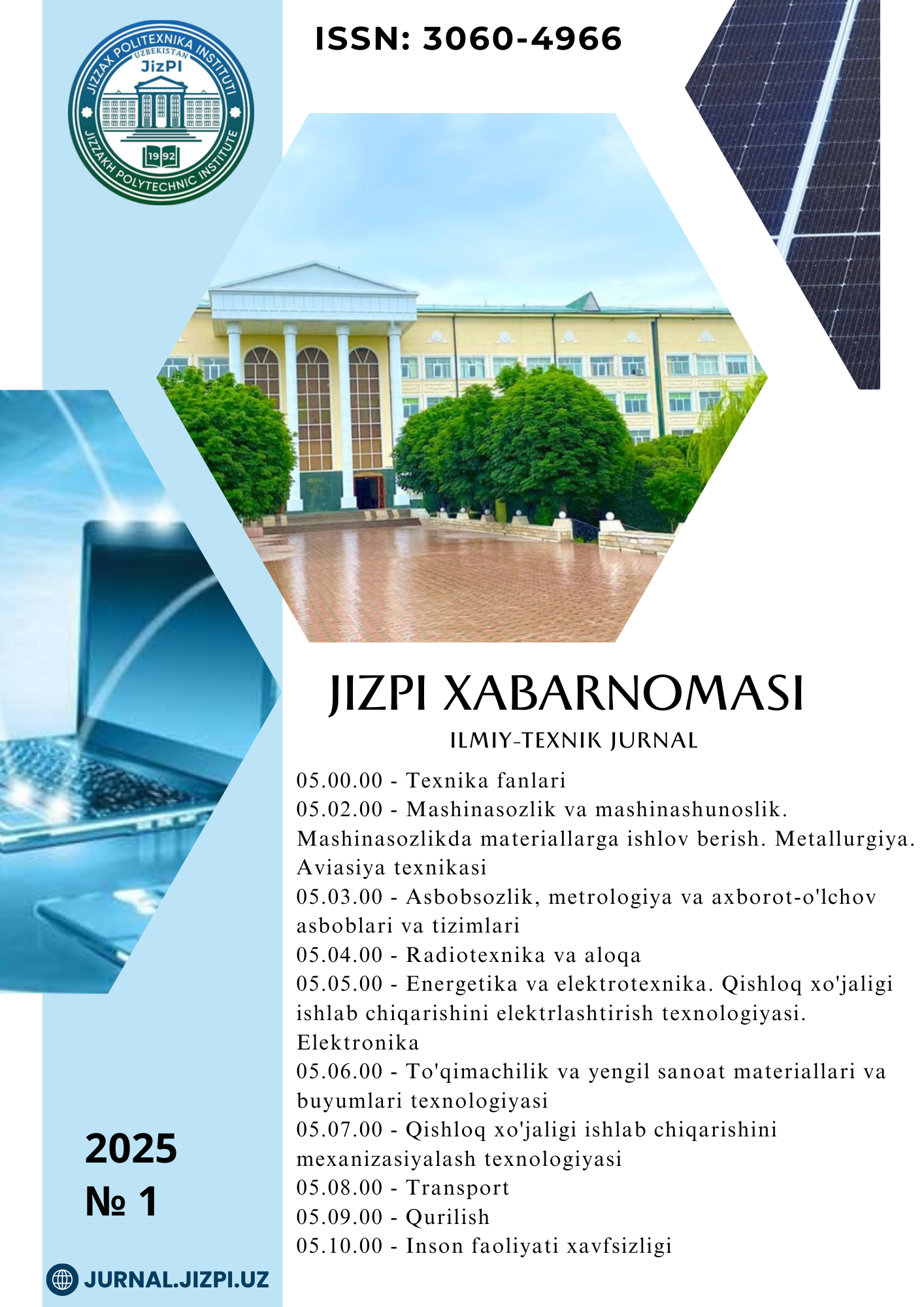PAХTA TOLASINI DASTLABKI TOZALASH MASHINASI KONSTRUKSIYASINI TAKOMILLASHTIRILISHI NATIJASIDA OLINGAN PILIK SIFAT KO‘RSATKICHLARINING TAHLILI
Keywords:
Paxta tolasi, dastlabki tozalash, pilik sifati, CL-P tozalash mashinasi, kalta tolalar, chang miqdori, yot aralashmalar, nepslar, , tozalash samaradorligi, Uster Statistics, paxta qayta ishlash, tolalar sifati, ip gazlamasiAbstract
Paxta tolalarini dastlabki tozalash bosqichida tolalar sifati va tozalash samaradorligini oshirish muhim masalalardan biridir. Ushbu tadqiqotda CL-P dastlabki tozalash mashinasining 2-barabanidagi tishlar miqdori va o‘lchamini o‘zgartirish orqali pilik sifatiga ta’siri o‘rganildi. Tajriba natijalariga ko‘ra, yangi konstruktsiya asosida ishlab chiqilgan tozalash mexanizmi kalta tolalar, chang va yot aralashmalar miqdorini kamaytirib, paxta tolalarining sifatini sezilarli darajada yaxshilagan. Olingan natijalar korxona varianti va Uster Statistics standartlari bilan taqqoslandi. Natijalar shuni ko‘rsatdiki, yangi konstruktsiyadagi tozalash mashinasi orqali ishlab chiqarish jarayoni samaradorligi oshirilishi va yuqori sifatli mahsulot olinishi mumkin
References
1. Uddin A.J., Roy P. Transforming melange fabric waste into melange yarn employing Compact-Siro and Compact-Siro spinning: A cleaner and sustainable strategy. ResearchGate, 2024. [Elektron resurs]: Havola
2. Kadam J., Rashid R., Jasur R. Analysis of improving cleaning efficiency in fiber cleaning machine in IP spinning factories. Universum: технические науки, 2024. [Elektron resurs]: Havola
3. Karimov D., Yugaev S. Results of theoretical research on the improvement of technological equipment for cleaning fiber dead. Universum: технические науки, 2024. [Elektron resurs]: Havola
4. Sulaymanov R.S., Omonov Z.J., Ismatov M.N. Study of the process of cleaning machine-harvested cotton from small impurities in saw gins. MJST Journal of Science and Technology, 2024.
5. Tuychiev T., Turdiyev H., Ruzmetov R. Research on an improved and set spiked cylinder 6A-12M1. BIO Web of Conferences, 2024. [Elektron resurs]: Havola
6. Nishonov I.A. Improvement of the grate grid of the 1VP fiber purifier. Western European Journal of Modern Science, 2024.
7. Ozturk E., Kitis M. Investigation of water and carbon footprint reductions em-ploying best available techniques in the textile sector. Journal of Cleaner Production, 2024.
8. Ling Y., Liu Y., Yin R., West A. An eco-friendly droplet-wet spinning tech-nology for producing high-quality hemp/cotton blend yarn. Journal of Cleaner Production, 2024.
9. Hibare, P.S., Deshmukh, B.B. (2021). Development of Air Controlled Cotton Cleaning Machine in Blow Room Part II Calculating Trash Content by Shirley Analyzer. In: Pawar, P.M., Bal-asubramaniam, R., Ronge, B.P., Salunkhe, S.B., Vibhute, A.S., Melinamath, B. (eds) Techno-Societal 2020. Springer, Cham. https://doi.org/10.1007/978-3-030-69925-3_58
10. Gupta A. K., Garde A. R., Grover J. M. Cleaning at Blow Room and Cards in Relation to the Nature of Trash in Cotton: Part I-Assessment of Trash Content. – 1978.
11. Robert, K., & Blanchard, L. (1997). Cotton Cleanability: Part I: Modeling Fiber Breakage. Textile Research Journal, 67, 417 - 427. https://doi.org/10.1177/004051759706700606.
12. Khan, R., Rashid, M., Ahmed, S., Rashid, E., & Haque, R. (2021). Investiga-tion Of Fiber Length Change In Different Stages Of Ring Spinning Process. Europe-an Scientific Journal ESJ. https://doi.org/10.19044/esj.2021.v17n25p66.
13. McCormick, K., Morais, J., Hequet, E., & Kelly, B. (2019). Development of the correction procedure for High Volume In-strument elongation measurement. Textile Research Journal, 89, 4095 - 4103. https://doi.org/10.1177/0040517519829002.
14. Tian, J., Zhang, X., Yang, Y., Yang, C., Xu, S., Zuo, W., Zhang, W., Dong, H., Jiu, X., Yu, Y., & Zhao, Z. (2017). How to reduce cotton fiber damage in the Xinjiang China. Industrial Crops and Products, 109, 803-811. https://doi.org/10.1016/J.INDCROP.2017.09.036.
15. Tian, J., Zhang, X., Zhang, W., Dong, H., Jiu, X., Yu, Y., & Zhao, Z. (2017). Leaf adhesiveness affects damage to fiber strength during seed cotton clean-ing of machine-harvested cotton. Industrial Crops and Products, 107, 211-216. https://doi.org/10.1016/J.INDCROP.2017.05.056.
16. Krifa, M. (2013). Cotton fiber length distribution modality alteration in ginning and mill processing. The Journal of The Textile Institute, 104, 731 - 744. https://doi.org/10.1080/00405000.2012.754117.
17. Krifa, M. (2009). A mixed Weibull model for size reduction of particulate and fibrous materials. Powder Technology, 194, 233-238. https://doi.org/10.1016/J.POWTEC.2009.04.011.
18. Krifa, M. (2008). Fiber Length Dis-tribution in Cotton Processing: A Finite Mixture Distribution Model. Textile Re-search Journal, 78, 688 - 698. https://doi.org/10.1177/0040517508083729.
19. Robert, K., Price, J., & Cui, X. (2000). Cotton Cleanability. Textile Re-search Journal, 70, 108 - 115. https://doi.org/10.1177/004051750007000204.
20. Hardin R. G. вa Byler R. K. Re-moval of sheet plastic materials from seed cotton using cylinder cleaner. Journal of Cotton Science. 2016, p. 375–385





